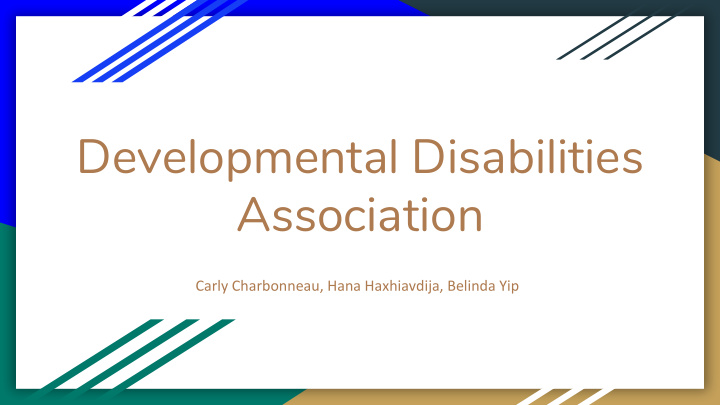



Developmental Disabilities Association Carly Charbonneau, Hana Haxhiavdija, Belinda Yip
Where did we go? ❖ Developmental Disabilities Association (DDA) for adults in Vancouver 7208 Main Street - Adult Drop-in Centre. ➢ ➢ Community living agency providing programs and services. Create extended networks of support, invest in individual needs, and strive for an ➢ inclusive and safe community. Activities are 1-4 hours long typically, varying each day ➢
What did we do?
Observation Visit: ❖ Short introduction of selves ❖ Asked clients specific oral and systemic health questions ➢ Conversation style only as resources were limited ❖ Gauged the client’s overall cognitive abilities
Key Information Found ❖ Clients possessed moderate knowledge of PSC and nutrition ❖ Best ways to implement: ➢ Hands on activities ➢ Discussion ➢ Visuals/Writing ❖ The clients supported and relied heavily on one another ➢ There were “clear” leaders in the group
Lesson 1: EO Exams & Diabetes ❖ 15 minute SAIL exercises - Level 1, 2, & 3 ❖ Instruction on the importance of EO and IO exams. ➢ Simple language to accommodate literacy level ❖ Demonstration of EO exam and time to try on themselves ➢ Distributed gloves and mask (optional) ❖ Skit depicting how uncontrolled diabetes affects gingival health. ➢ Repeated several times to solidify knowledge ➢ Asked clients to repeat to evaluate comprehension
What We Noticed During Our First Lesson ❖ Assess comprehension on client facial expression ❖ There was mixed participation with the activities ➢ Some wanted to sit during the exercise, even though they were capable to stand ➢ Some did not like the gloves and mask ❖ Clients preferred “big muscle” exercises ❖ Adapt!
Lesson 2: Healthy Foods & Nutrition Labels ❖ 15 minute ZUMBA exercise portion ➢ First circuit: presenters lead ➢ Second circuit: clients lead ❖ Pictionary activity to sort food groups ➢ Food item drawn, clients guess ➢ Client guessing correctly will stick the food item in the appropriate category ❖ Highlighting sugar & fat on nutritional label ➢ Instruction on flip chart paper ➢ Partners given item to highlight sugar ➢ Sort in ascending order of sugar content ❖ Goodie bags - brief PSC review
What We Noticed During Our Second Lesson ❖ Clients enjoyed leading the exercise portion. ❖ Higher attendance and late attendance resulted in modifications ➢ Pictionary: shortened activity resulted in not all clients having a turn ➢ Nutrition Labels: clients were asked to partner up since there were not enough items individually
Highlights and Challenges
Highlights ❖ Most clients had high motivation to learn ➢ Answered questions when prompted ❖ Clients who were apprehensive at first eventually opened up ➢ First implementation: not as much participation during the exercise portion ➢ Second implementation: more participation, interaction, and leadership from clients
Challenges ❖ As clients were unfamiliar with us, they behaved apprehensively when given instruction at first ➢ The group experienced the loss of a vital member recently, morale was lower during the assessment visit ❖ Difficulty with demonstrating exercises as some clients preferred to sit while others used walkers Some clients were more vocal than others → difficult to “call on” quiet ❖ students as we did not want to make them uncomfortable ❖ One non-verbal student: although written instructions were given, sometimes it was unclear whether she simply did not want to participate or was confused.
Future Recommendations
For Future Presenters ❖ Consider cognitive and physical abilities ➢ Use repetitive, simple language to address literacy level ➢ Speak loudly and use speakers for music as some clients have hearing impairment ❖ Use interpersonal skills to assess student’s comprehension ❖ Big group instruction instead of splitting the class up ❖ Encourage client initiative and participation in activities ❖ Seek help from coordinators and do adequate preparation prior to lessons.
Final Thoughts
Thank you! Questions?
Recommend
More recommend